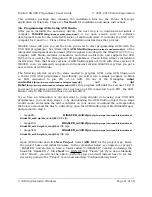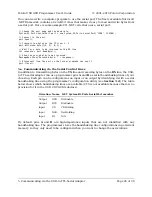
Pololu USB AVR programmer configuration utility for Windows.
Target VDD Monitor
The USB AVR programmer monitors the voltage of the target AVR while it is being
programmed to ensure that ISP commands are only sent when the AVR’s VDD is at a safe
level, since attempting to program an underpowered AVR can permanently disable it. There
are two parameters that control this feature:
•
Minimum Allowed:
This parameter determines the lowest level (in millivolts) that
the target AVR’s VDD is allowed to go. If the target AVR’s VDD drops below this level,
the programmer immediately aborts programming and turns on the red programming
LED. Lowering this value will allow programming of AVRs at lower voltages, but will
make it more likely that the programmer will send ISP commands to the AVR while the
AVR is running at an unsafe voltage. The default value is 4384 mV.
•
Maximum Range Allowed:
This parameter determines how much the target AVR’s
VDD measurements are allowed to vary (in millivolts). When the programmer recieves
an ISP programming request, it starts keeping track of the maximum and minimum
measurements of the AVR’s VDD. If the difference between the maximum and minimum
exceeds the allowed maximum range, the programmer immediately aborts programming
and turns on the red programming LED. Increasing this value will allow programming
of AVRs under less stable power conditions, but will make it more likely that the
programmer will send ISP commands to the AVR while the AVR is running at an unsafe
voltage. The default value is 512 mV.
Measurements From Last Programming
This section displays the minimum and range of the target VDD measurements from the last
time the programmer was in programming mode or tried to enter programming mode. This
can help determine whether programming problems are due to the target’s power supply.
Error From Last Programming
When an error or unexpected condition causes the programmer to leave programming mode,
or fail to enter programming mode, then the programmer turns on the red LED and records
Pololu USB AVR Programmer User's Guide
© 2001–2010 Pololu Corporation
3. Getting Started in Windows
Page 18 of 36
















































